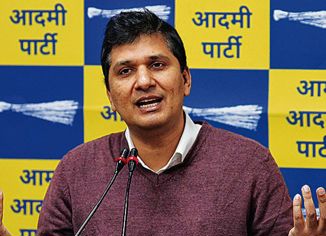
PATRIOTISM AS RITUAL? The audience stands while the national anthem is being played in a New Delhi movie-hall. AFP
Apoorvanand
THE nationalism discourse which started with the advent of the present government of the BJP, the political arm of the RSS, at the Centre touched a new low recently. A two-judge bench of the Supreme Court issued a directive as part of an interim order that all films should now be viewed with nationalist eyes. Nationalism has to be drummed into the heads of the cine-watchers by playing the national anthem before the film starts, with all doors closed and the audience left with no option but to stand up and imbibe constitutional patriotism by fixing their eyes on the Tricolour on the screen and sounds emanating from the speakers. The bench does not want a song and dance about nation, so we expect not a fluttering but a stately static tricolour to shame us into nationalism.
People are disappointed, questions are being asked whether the learned judges have not overreached in their zeal to nationalise the nation. The most worrying part of the judgment, however, is that the judge who wrote it would be heading the Supreme Court soon. So, we better take a deep breath to receive more of the kind in the coming years. Nationalism is like religion. Are you born religious? Do you get it automatically from somewhere? No. You need to be schooled in the rites and norms of the religion. There is always a suspicion in the minds of the purohits and pandas of the cult that the followers suffer from a permanent lack. They prescribe daily private and periodic collective rituals to keep religiosity alive. Reformers who have tried to de-ritualise religions and get the pure kernel of it are sadly mistaken. Religion without its ritual part is beyond human comprehension.
Have you not seen people who fill their notebooks with Ram naam? In our culture, Naam jaap enjoys great respect. But Naam is an abstraction. Unless you put a face to a name it is meaningless. So Naam has to combine with roop. What is the roop, or face of this nation? Before answering this, let us recount a story that is part of our Puranic tradition but which must be a product of the folk genius of this ancient nation that never misses a chance to puncture the claims of high culture. It is about the venerated Narada who keeps chanting “Narayana, Narayana” during his cosmic wandering. One day, filled with the pride of his bhakti, he went to Narayana to stake claims for the post of his first devotee. Narayana smiled and nodded at the demand. Who remembered him more than him, the hurt bhakt asked. Narayana pointed in the direction of the mortal earth. A farmer tilling his fields! Go to him, commanded the all-pervading life-giver.
Narada rushed to the earth with divine speed to encounter his competitor. He followed him closely without being seen. The poor man was busy with his dailyness. There was nothing spiritual about what he was doing. Caught in his mundane existence, the name of the supreme never appeared on his lips. When the eventless day drew to its close, the tiller before retiring to his bed or whatever was there in the name of it, whispered, “Ram, Ram”. Narada was filled with indignation. Only once in a day and that too as a lullaby! And the Lord has the cheek to pitch him against me with whose very existence is woven the name of the Almighty! Without losing time, he returned to Naryana and asked how could he be compared with the lowly farmer. Narayana proposed a test. Narada had to carry a bowl filled to the brim with oil on his head for a day. The condition was that he had to come back to him without spilling a drop of it. Narada was amused but did he have an option to tell his master that this was no way to test his loyalty? He put the oil-filled bowl on his head and started his journey. Constantly aware of the condition, he moved around without letting a drop fall. At sunset, he returned to the all-knowing, filled with a feeling of triumph: he had passed the test. Despite having cosmic ears, Narayana asked him how many times he had remembered him. Narada was dumbfounded. Not once! His mind was constantly on the oil- bowl and the godly condition. “See, you forgot me completely and how!”
In the old story-telling ways, there was always a scope for the moral of the tale. Modern fiction sneers at moralising, so let us be content with the story. We know that by making him enact a story, Narayana could not mend the ways of Narada. He still roams around with his veena and his chant and the farmer still goes on tilling his land and from time to time, hangs himself, not by the thread of Ram Naam but with a noose around his neck. Religions have lived through stories. Nations also fictionalise themselves to be communicable to their people. But stories which are written with a mission of moralising bore their listeners. They have to endear themselves to their readers. They have to be humorous, erotic, unpredictable to keep the readers with them while they unfold. A good reader is one who reads his novel at least twice. And good novels are mines which are dug again and again by the readers for new gems of meanings.
Nations, to be alive for their people have to have this aesthetic appeal in them. They are a two-way meaning-making exercise. They also have to find meaning in their people. They have to have a sense of incompletion in them, a sense of inadequacy. They wait for new readers. They are unfinished paintings, there always a scope for a new stroke, a fresh colour. They are not sacred , museum pieces not to be touched and altered. They need to soiled by impure,working hands. Our good lordships know their Ramayana and shastras for they did remember the oft-quoted Janani Janmabhumishcha. They are better advised to visit them again to read them as tales of exiles and think somewhat deeply about the final exile which Sita had to endure. What was the nation of Sita, my lordships? Ram did return to his Ayodhya. But where did Sita return? Why did she not accept the invitation of the Ayodhyapati Ram to come back and preferred to disappear? How did Ayodhya lose its inviting charm? Read the Ramayanas again my lords, there are at least 300 of them!
The writer is a Professor of Hindi at Delhi University.






















